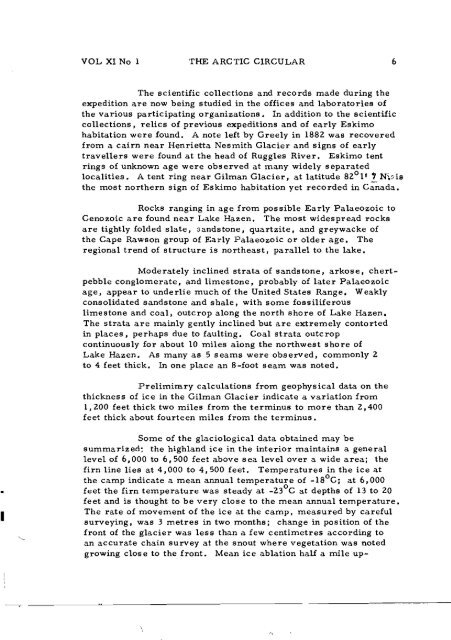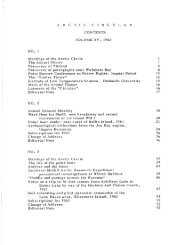Volume 11, 1958 - The Arctic Circle - Home
Volume 11, 1958 - The Arctic Circle - Home
Volume 11, 1958 - The Arctic Circle - Home
Create successful ePaper yourself
Turn your PDF publications into a flip-book with our unique Google optimized e-Paper software.
VOL Xl No 1 THE ARCTIC CIRCULAR 6<br />
<strong>The</strong> scientific collections and records made during the<br />
expedition are now being studied in the offices and laboratories of<br />
the various participating organizations. In addition to the scientific<br />
collections, relics of previous expeditions and of early Eskimo<br />
habitation were found. A note left by Greely in 1882 was recovered<br />
from a cairn near Henrietta Nesmith Glacier and signs of early<br />
travellers were found at the head of Ruggles River. Eskimo tent<br />
rings of unknown age were observed at many widely separated<br />
localities. A tent ring near Gilman Glacier, at latitude 82 0 1 1 ! N'~,;is<br />
the most northern sign of Eskimo habitation yet recorded in Canada.<br />
Rocks ranging in age from possible Early Palaeozoic to<br />
Cenozoic are found near Lake Hazen. <strong>The</strong> most widespread rocks<br />
are tightly folded slate, sandstone, quartzite, and greywacke of<br />
the Cape Rawson group of Early Palaeozoic or older age. <strong>The</strong><br />
regional trend of structure is northeast, parallel to the lake.<br />
Moderately inclined strata of sandstone, arkose, chertpebble<br />
conglomerate, and limestone, probably of later Palaeozoic<br />
age, appear to underlie much of the United States Range. Weakly<br />
consolidated sandstone and shale, with some fossiliferous<br />
limestone and coal, outcrop along the north shore of Lake Hazen.<br />
<strong>The</strong> strata are mainly gently inclined but are extremely contorted<br />
in places, perhaps due to faulting. Coal strata outcrop<br />
continuously for about 10 miles aiong the northwest shore of<br />
Lake Hazen. As many as 5 seams were observed, commonly 2<br />
to 4 feet thick. In one place an 8-foot seam was noted.<br />
Prelimimry calculations from geophysical data on the<br />
thickness of ice in the Gilman Glacier indicate a variation from<br />
1,200 feet thick two miles from the terminus to more than 2,400<br />
feet thick about fourteen miles from the terminus.<br />
Some of the glaciological data obtained may be<br />
summarized: the highland ice in the interior maintains a general<br />
level of 6,000 to 6,500 feet above sea level over a wide area; the<br />
firn line lies at 4,000 to 4,500 feet. Temperatures in the ice at<br />
the camp indicate a mean annual temperature of _18 0 C; at 6,000<br />
• feet the firn temperature was steady at _23 0 C at depths of 13 to 20<br />
feet and is thought to be very close to the mean annual temperature.<br />
<strong>The</strong> rate of movement of the ice at the camp, measured by careful<br />
I<br />
surveying, was 3 metres in two months; change in position of the<br />
front of the glacier was less than a few centimetres according to<br />
an accurate chain survey at the snout where vegetation was noted<br />
growing close to the front. Mean ice ablation half a mile up<br />
\












